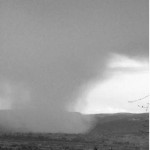I’ve been playing in Okanagan Lake since I was a baby; swimming in it and skipping stones on it since I was a toddler; boating on it and fishing its depths since I was a child; and drinking it most of my life.
Apparently, the same water I played in as a baby, I fished in last week, and drank this week, because it takes an estimated 60 years for water to move through this big lake. There’s a very small amount of precipitation that falls in this valley every year—and I’m not yet 60!
This means that there could still be some chemicals in it from the suntan lotion I used when I went swimming several decades ago, not to mention more recently, if they are soluble in water and have a long residual in the environment like DDT does.
There’s so much we don’t know about, particularly about chemical compounds we’ve only been using in relatively-recent years, that we’re better off being cautious than not when it comes to discharging them into the environment.
However, few of us think much about what goes through our sewage treatment plants.
And, we should.
It’s just one issue that was highlighted during the past three days at the One Watershed—One Water conference held in Kelowna by the Okanagan Basin Water Board and the Canadian Water Resources Association.
In order to find out how much water we have in this valley to use, there’s a water supply and demand study underway. As a layman, I wouldn’t have thought to consider the rate of evaporation from that big lake, yet it’s a huge factor in water losses from the valley.
Groundwater is another enormous question in this basin, because well water is not licensed like surface water is, so we don’t even know where all the aquifers are, how much they contain or how they interact with surface water.
Climate change throws a real wrench into the mix.
There are three regional districts, 12 local governments, 60 water purveyors and 81 sub basins in the Okanagan. But they’ve all gotten together to ensure that research gets underway on all fronts to get the facts and figures to plug into the main study.
It may seem late to be gathering all this information, with the rapid pace of development and the surge in population in recent years here, but it’s better late than never.
And, it all seems to have happened because of the drought in 2003.
Okanagan Lake was within about a metre of no longer flowing into the Okanagan River channel, and there was a year or two there when the winter snows didn’t fill the big lake when they melted.
Today, it would seem we’re finally going to get together and begin to plan for the next such event, using science as the basis for our plans.
Kudos to the OBWB and the rest of the valley’s politicians who’ve made the decision to forge ahead; to set aside their parochial differences and work together throughout the valley to properly manage its water resource.
Judie Steeves writes about outdoors issues for the Capital News.

